
Image Source.
Most of the hot Jupiters with periods that last less than a week have orbits that are nearly circular. Tidal dissipation in a body on a short-period eccentric orbit is very strong. The net result of tidal dissipation is that energy of orbital motion is turned into heat. Io is the poster-world example of this phenomenon in our solar system.
There are, however, two hot Jupiters — HD 118203b and HD 185269b — that have orbital periods of less than a week, and eccentricities, e~0.3. Indeed, a quick glance at the radial velocities for HD 185269 phased at 6.838 days shows that the variation is not a perfect sinusoid.

With its eccentricity of 0.3, HD 185269b should have long since been delivered into a state of spin pseudosynchronization, in which it spins roughly three times on its axis for every two trips around the parent star. This state of affairs prevents a steady state flow pattern from developing, and hence the weather on this world is likely to be much more interesting than on your standard-issue tidally circularized hot Jupiter. Furthermore, the amount of energy absorbed by the planet is 345% greater at periastron than at apastron, which will also contribute to a strong “seasonal” variation during the planet’s 6.838-day year.
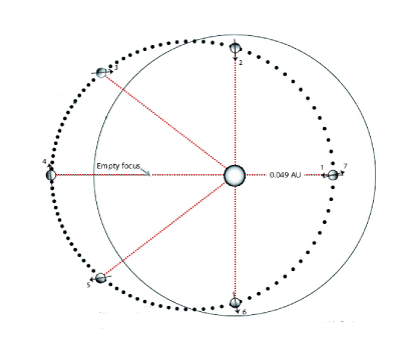
HD 185269b was discovered by John Johnson, who has been carrying out a radial velocity survey of luminous Hertzsprung-gap stars (discovery paper here). The stars in his survey are more massive than the Sun, and are in the midst of ending the core hydrogen-burning phase of their life cycles. They’re in the process of turning into red giants, and are thus cool enough to be profitably observed with the Doppler radial velocity technique. (See this post for more on John’s survey and its implications). HD 189269 is about four times more luminous than the Sun, and so the surface of the planet should average out at ~1300 K, which is quite hot, even for a hot Jupiter.
UCSC graduate student Jonathan Langton has been making great progress in his hydrodynamical calculations of the global surface flows on extrasolar planets. His code (which he’s written from scratch during the past year) now has a more sophisticated scheme for time-dependant radiative transfer, and is ideal for simulating the weather on planets like HD 185269b, and HD 80606b that are subject to strongly varying fluxes of radiation. We’re getting close to submitting a paper on his research, which will have predicted light curves for all of the known planets that are potentially bright enough to be observed with the Spitzer Space Telescope.
Here’s a sequence of images (each spaced by a bit more than a day) which show the global weather map for HD 185269 b as computed by Jonathan’s code. The view is from a camera that hovers above a fixed spot on the surface, and thus rotates with the planet. The color-scale is chosen to roughly approximate what the eye might see in the absence of clouds in the atmosphere. The brightest yellow regions have a temperature of ~1500K, and the coolest regions are down at ~900K. In this approximation, it’s best to think of the planet as a gigantic transparent molten marble.
In the third frame, we’re getting a good view of the heating that occurs on the hemisphere of the planet that is subject to the brunt of the insolation delivered during the periastron passage. The rapid heating of the atmosphere drives an intense global storm that is still shedding vortices and dissipating when the next wave of heating begins to hit.
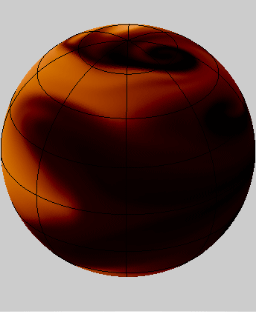
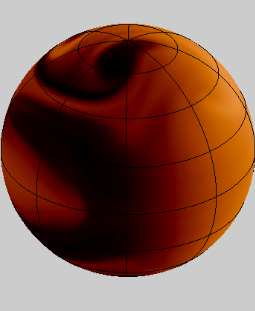
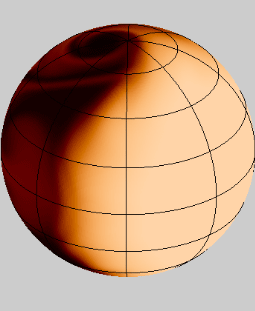
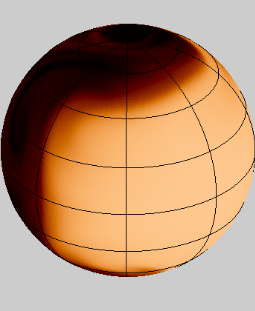
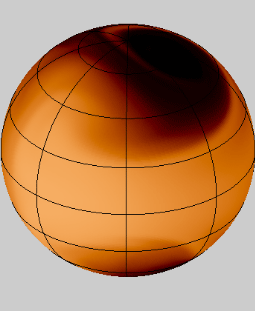
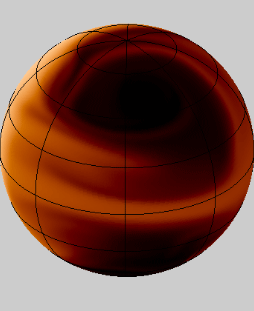
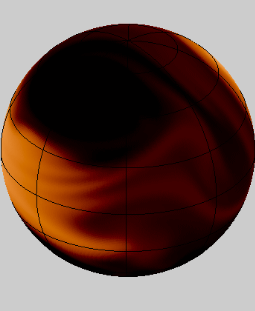
It’s quite a fascinating flow, and it’s best visualized if you take the time to download the animations. Here are links to the movies: The first movie animates the temperature of the flow pattern for a full 6.838-day orbital period as viewed from a camera placed above the eastern hemisphere, and the second movie animates the temperature of the flow pattern for the same period from a camera placed above the western (opposite) hemisphere. These are 1.2 MB .avi format files. Run them on loop for a groovy lava lamp effect, and better yet, place them near a copy of the downloadable systemic console to make your desktop look like self-contained Institute for Exoplanetary Studies.
If the above .avi files don’t play on your machine, you’ll likely need to download the Xvid component for QuickTime (or an appropriate player for your OS). They are available here, and are trivial to install on Mac OSX 10.4 (Thanks for pointing me to the link, Andy!) If you can’t get the animations to play, here are links to the original .avi files for the first movie and the second movie. These are 41 MB .avi format files. I’ve put them on the UCO/Lick Server in order to keep our friends at Bluehost from wigging out and going into overload mode…

Those movie files are huge! Are you using any kind of compression algorithm at all? Using the XviD codec, I’ve managed to get the first one down to 1.24 MB without noticeable loss of quality, probably could squeeze it down further if I messed around with it a bit more.
Hi Andy,
I was having problems squeezing them down using i-movie. Could you send me the 1.24 MB version? I’ll
then replace the large file with the smaller one.
best,
Greg
Hi Andy,
Thanks for sending the files, I’ve posted your compressed versions. They look great with no noticeable loss of quality (after I downloaded the XviD plug-in for QuickTime). I’m leaving the 41MB versions on the ucolick server for the time being.
best,
Greg
The problem is in the .avi.
I do not know why people uses it. mpeg is better.
in Quick Time mov format is 1.1 Mb
Mike
mike: AVI is just a container format, so is MOV – they can both contain a variety of formats, provided a codec is available.
MPEG on the other hand represents a group of specific algorithms, such as mpeg-1 and mpeg-4. The comparison between MPEG and AVI or MOV is a bit like comparing a box which contains an object with the object itself.
Pingback: systemic - Vorticity